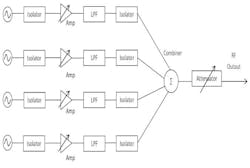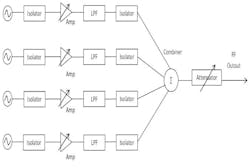Multi-Tone Testing Multiplies Test Solutions
This file type includes high resolution graphics and schematics when applicable.
By performing multi-tone testing, a large number of benefits can be achieved. For instance, equipment efficiency can be improved and equipment-under-test (EUT) can be tested under real-world threat conditions. Faster time-to-market for both new and enhanced products is another benefit of this approach. In the application note, “Multi-Tone: Testing, Theory and Practice,” AR RF/Microwave Instrumentation discusses the multi-tone test methodology. The document explains how this approach can be implemented, as well as the advantages of using this method.
The application note begins with a basic definition of a multi-tone signal. An explanation of how these signals are represented in both the frequency- and time-domains is presented. Modern audio measurements are one example of an application that utilizes multi-tone signals. Intermodulation distortion (IMD) measurements are mentioned, as multi-tone signals are used to test the nonlinear distortion of amplifiers and receivers.
Various methods of generating multi-tone signals are explained. The traditional approach is to generate multiple signals by using multiple independent continuous-wave (CW) generators that are added together with a combiner. Alternately, multiple signals can be generated by using one vector signal generator (VSG) in place of multiple CW generators. A VSG can generate fixed or random initial phase sets, deliver accurate repeatable multi-tone signals, and is easily configurable by independently setting each tone. The third approach is to use multiple signal generators, multiple amplifiers, and multiple antennas. When using this technique, the signals are actually combined in free space. Furthermore, a comparison between analog signal generators and VSGs is provided.
Electromagnetic-compatibility (EMC) testing with multi-tone signals is analyzed. By using a VSG with a frequency selective power measurement device like a vector signal analyzer (VSA), multiple tones can be generated, measured, and controlled. An explanation of how test times can be reduced by using a multi-tone test method is provided. Real-world threats can also be simulated by using this test approach, as EUTs can be exposed to more than one tone at a time in real-world applications.
AR RF/Microwave Instrumentation, 160 School House Rd., Souderton, PA 18964-9990
Looking for parts? Go to SourceESB.
This file type includes high resolution graphics and schematics when applicable.


